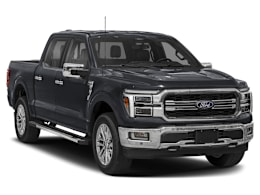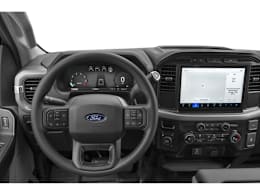The F-150 was redesigned for 2021 with a mildly updated exterior, an upgraded cabin, the first-ever hybrid model, and more tech and innovative work-related features. Even with all that, the workhorse-tough F-150—long America’s best-selling vehicle—didn’t make a significant step forward overall, with only incremental improvements in ride comfort and handling agility.
We purchased a Lariat hybrid as well as a conventional XLT. Based on the 3.5-liter turbocharged V6 and with 430 horsepower on tap, the hybrid is among the brawniest in the F-150 lineup (aside from the high performance F-150 Raptor and all-electric Lightning), with what feels like a nearly bottomless amount of power along with an impressive 12,400-pound tow rating. We weren’t thrilled with the hybrid’s occasional rough downshifts, though. The non-hybrid XLT version with the 325-hp, 2.7-liter turbo V6 may not have the grunt of the hybrid or its towing capacity (rated at 7,700 pounds for our test truck), but it’s still a gem, with loads of low-end power and timely, smooth shifting from its 10-speed automatic transmission.
Although the aptly named “PowerBoost” hybrid 4WD is rated at 24 mpg combined by the EPA’s lab testing, our on-road testing resulted in 20 mpg overall. The gas-only version registered at 19 mpg overall, identical to our 2018 tested model.
The F-150’s ride is slightly less jittery than before, though still a far cry from the plush comfort the Ram 1500 delivers, and it trails the Chevrolet Silverado 1500 and GMC Sierra 1500 twins, too. The steering remains slow and the handling fairly clumsy, but both F-150s proved very secure when pushed to their limits around our test track.
It takes a big step to get up inside the F-150’s cabin, even with the running boards on our test trucks, but the crew-cab versions have lots of passenger space, and the interior rivals luxury cars in terms of quietness. An optional foldaway gear selector cleverly enables a flat workspace on the center console that could be used for laptops, filling out paperwork, or taking a lunch break. Ford’s new Sync 4 infotainment system is a model of user-friendliness.
Ford also redesigned the F-150’s tailgate so it can better serve as a workbench, with built-in clamp pockets to hold materials—such as lumber—when making cuts with a saw, and cleats mounted on the sides of the tailgate act as tie-down locations to hold extra-long items in the bed when the tailgate is dropped, a common event due to the short, 5½-foot bed configuration that most F-150s come in these days.
The hybrid model comes with a Pro Power Onboard feature that allows the truck to be used as a mobile generator producing 2.4 kW, with dual 120-volt 20-amp outlets in the bed, which Ford claims can power a couple of saws and an air compressor with an 85-hour run time on a full tank of gas. A slightly less powerful version is available on non-hybrid F-150s, and the hybrid has an optional 7.2-kW system that could potentially power your entire house in the event of an outage.
All F-150s come standard with forward collision warning and automatic emergency braking with pedestrian detection, which we applaud.























